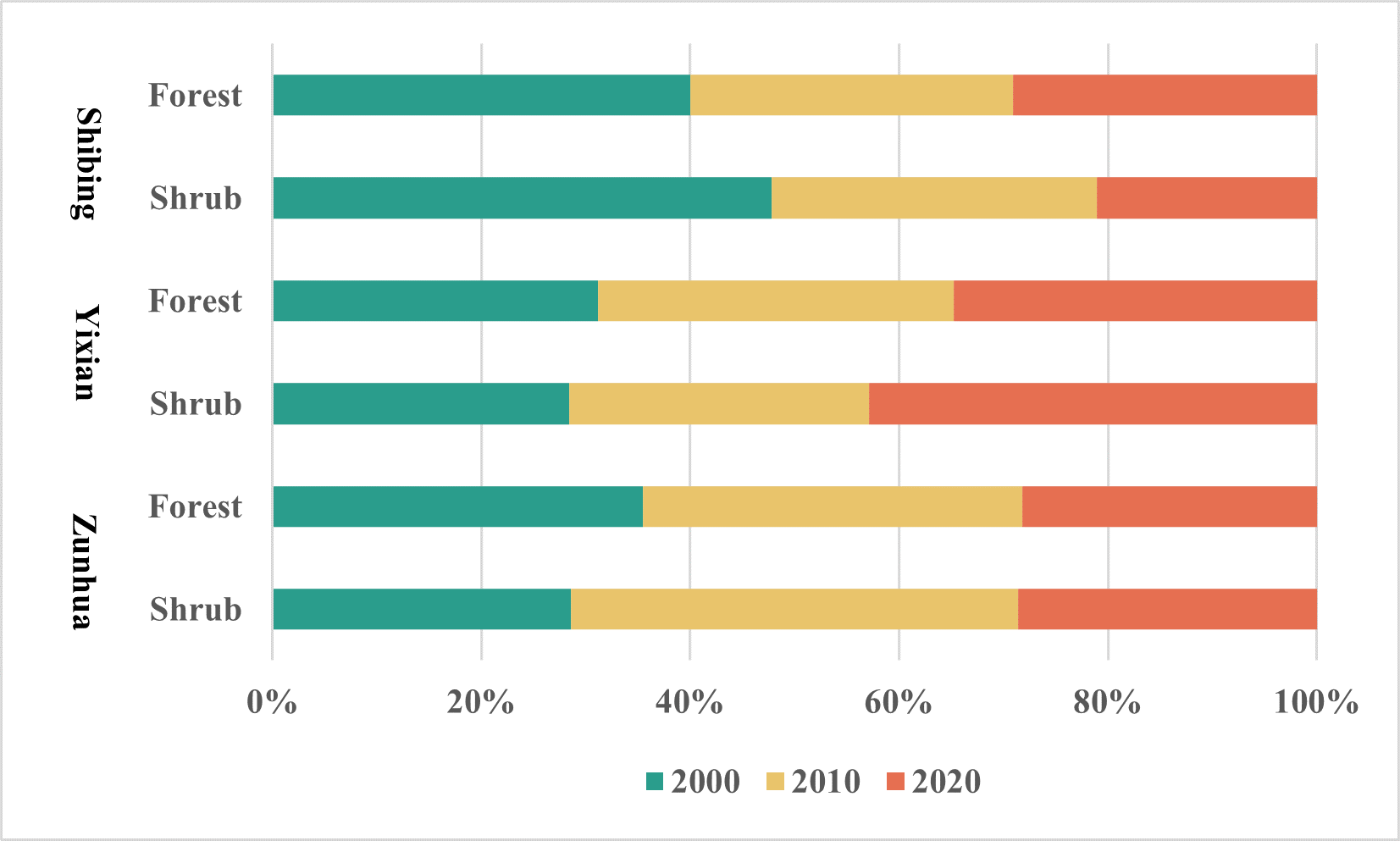Study on Forest Eco-Products Value Changes for Karst Desertification Control in South and North China
Abstract
The forests in the dolomite karst region provide people with a variety of ecological products, and the realization of its value is related to the protection of forests and the well-being of local residents. In this paper, the spatial and temporal pattern and change rule of the value of forest ecological products from 2000 to 2020 are investigated through three forest study areas in China's southern and northern rocky desertification control. The equivalent factor method is used to calculate the value of forest ecological products, and Arc GIS and other tools are used for visualization and analysis. It was found that the forest land area in the three study areas was mainly forest-dominated, and the value of ecological products showed a fast and then slow decline rate in the southern region. The two study areas in the north, on the other hand, showed a gradual increase over the years in the study area of Yixian, while Zunhua showed an increasing and then decreasing trend of change. Meanwhile, different ecological product value realization path models are proposed according to the value changes in the study areas. The results of the study provide theoretical and practical support for the sustainable development of forests in karst desertification control areas, and have important academic and application values.
References
[2] Yuan, D. X. (2001). Global comparison of karst ecosystems: Scientific objectives and implementation plan. Advances in Earth Science, 16, 461–466.
[3] Ford, D., & Williams, P. (2007). Karst hydrogeology and geomorphology (Rev. ed.). Wiley. https://doi.org/10.1002/9781118684986
[4] Tang, J., Tang, X. X., Qin, Y. M., He, Q. S., Yi, Y., & Ji, Z. L. (2019). Karst rocky desertification progress: Soil calcium as a possible driving force. Science of the Total Environment, 649, 1250–1259. https://doi.org/10.1016/j.scitotenv.2018.08.312
[5] Jiang, Z. C., & Yuan, D. X. (2003). Comprehensive management countermeasures for rocky desertification in karst areas of southwest China. In Sino-US Seminar on Water & Soil Conservation (pp. 5). Beijing, China.
[6] Yu, L. F., Zhu, S. Q., Zhu, X. K., & Xie, S. X. (2002). Rehabilitation assessment and restoration techniques for degraded karst forests. Guizhou Science, 20(7–13).
[7] Zhang, G., Zhu, Y., & Shou, M. (2019). Mechanisms of Earth’s critical zone processes and sustainable utilization of soil and water resources. Scientia Sinica Terrae, 49, 1945–1947.
[8] Zhang, T. Y., Cheng, C. X., & Wu, X. D. (2023). Mapping the spatial heterogeneity of global land use and land cover from 2020 to 2100 at a 1 km resolution. Scientific Data, 10, 15. https://doi.org/10.1038/s41597-022-01950-9
[9] Hao, C., Wu, S., Zhang, W., Chen, Y., Ren, Y., Chen, X., Wang, H., & Zhang, L. (2022). A critical review of gross ecosystem product accounting in China: Status quo, problems and future directions. Journal of Environmental Management, 322, 115995. https://doi.org/10.1016/j.jenvman.2022.115995
[10] Costanza, R., d’Arge, R., de Groot, R., Farber, S., Grasso, M., Hannon, B., Limburg, K., Naeem, S., O’Neill, R. V., Paruelo, J., Raskin, R. G., Sutton, P., & van den Belt, M. (1997). The value of the world’s ecosystem services and natural capital. Nature, 387, 253–260. https://doi.org/10.1038/387253a0
[11] Daily, G. C., Polasky, S., Goldstein, J., Kareiva, P. M., Mooney, H. A., Pejchar, L., Ricketts, T. H., Salzman, J., & Shallenberger, R. (2009). Ecosystem services in decision making: Time to deliver. Frontiers in Ecology and the Environment, 7(1), 21–28. https://doi.org/10.1890/080025
[12] Xie, G., Zhang, Y., Lu, C., Zheng, D., & Cheng, S. (2001). Value of natural grassland ecosystem services in China. Journal of Natural Resources, 16(1), 47–53.
[13] Wang, L., Xiao, Y., Ouyang, Z., Wei, Q., Bo, W., Zhang, J., & Ren, L. (2017). Research on gross ecosystem product accounting in national key ecological function area counties—Taking Arshan City as an example. China Population, Resources and Environment, 27(10), 146–154.
[14] Xu, Y. Q., & Xiao, F. J. (2022). Assessing changes in the value of forest ecosystem services in response to climate change in China. Sustainability, 14(22), 15138. https://doi.org/10.3390/su142215138
[15] Liu, Y. T., & Qiao, X. J. (2023). Spatial and temporal variation of ecosystem service value: A case study of the Qingling National Park in China. Applied Ecology and Environmental Research, 21(5), 4517–4529. https://doi.org/10.15666/aeer/2105_45174529
[16] Xie, G. D., Zhang, C. X., Zhen, L., & Zhang, L. M. (2017). Dynamic changes in the value of China’s ecosystem services. Ecosystem Services, 26, 146–154. https://doi.org/10.1016/j.ecoser.2017.06.010
[17] Kenter, J. O. (2016). Editorial: Shared, plural and cultural values. Ecosystem Services, 21, 175–183. https://doi.org/10.1016/j.ecoser.2016.10.010
[18] Saladini, F., Gopalakrishnan, V., Bastianoni, S., & Bakshi, B. R. (2018). Synergies between industry and nature—An emergy evaluation of a biodiesel production system integrated with ecological systems. Ecosystem Services, 30, 257–266. https://doi.org/10.1016/j.ecoser.2018.02.004
[19] Crouzeilles, R., Ferreira, M. S., Chazdon, R. L., Lindenmayer, D. B., Sansevero, J. B. B., Monteiro, L., Iribarrem, A., Latawiec, A. E., & Strassburg, B. B. N. (2017). Ecological restoration success is higher for natural regeneration than for active restoration in tropical forests. Science Advances, 3(11), e1701345. https://doi.org/10.1126/sciadv.1701345
[20] Cao, S., Chen, L., & Yu, X. (2009). Impact of China’s Grain for Green Project on the landscape of vulnerable arid and semi-arid agricultural regions: A case study in northern Shaanxi Province. Journal of Applied Ecology, 46(3), 536–543. https://doi.org/10.1111/j.1365-2664.2008.01605.x
[21] Chen, L. D., Wei, W., Fu, B. J., & Lü, Y. H. (2007). Soil and water conservation on the Loess Plateau in China: Review and perspective. Progress in Physical Geography, 31(4), 389–403. https://doi.org/10.1177/0309133307081290
[22] Li, Y., Geng, H. C., & Bai, X. Y. (2022). Response of ecosystem service functions to land use changes in a typical karst basin since the 21st century. Bulletin of Mineralogy, Petrology and Geochemistry, 41(6), 1051–1059.
[23] Chen, T. T., Huang, Q., & Wang, Q. (2022). Characterization of ecosystem service relationship differentiation and analysis of driving force in karst mountainous area based on geodetector—Taking Guizhou Province as an example. Acta Ecologica Sinica, 42(17), 6959–6972.
[24] Xiong, K. N., Chen, Y. B., Chen, H., & Sui, Z. (2011). Turning stones into gold: Guizhou’s rocky desertification control technology and model. Guizhou Publishing House.
[25] Xie, G. D., Zhang, C. X., Zhang, C. S., Xiao, Y., & Lu, C. X. (2015). The value of ecosystem services in China. Resources Science, 37(9), 1740–1746.
[26] Ouyang, Z. Y., Zhu, C. Q., Yang, G. B., Xu, W. H., Zheng, H., Zhang, Y., & Xiao, Y. (2013). Ecosystem gross domestic product accounting: Concepts, accounting methods, and case studies. Acta Ecologica Sinica, 33(21), 6747–6761.
[27] Zhang, Z. Z., Xiong, K. N., Huang, D. H., Zhang, W. X., & Chang, H. H. (2023). Spatial zoning of the value realization models for ecological products in Shibing Karst Natural World Heritage Site. Forests, 14(7), 1449. https://doi.org/10.3390/f14071449


This work is licensed under a Creative Commons Attribution 4.0 International License.
Copyright for this article is retained by the author(s), with first publication rights granted to the journal.
This is an open-access article distributed under the terms and conditions of the Creative Commons Attribution license (http://creativecommons.org/licenses/by/4.0/).
























